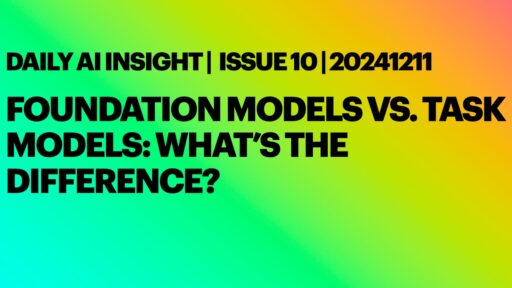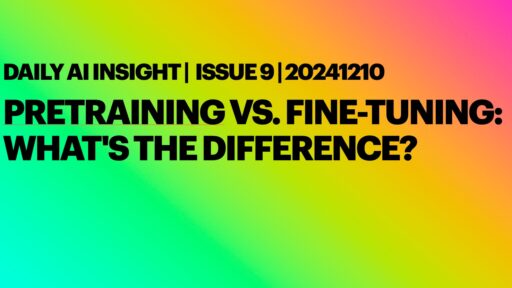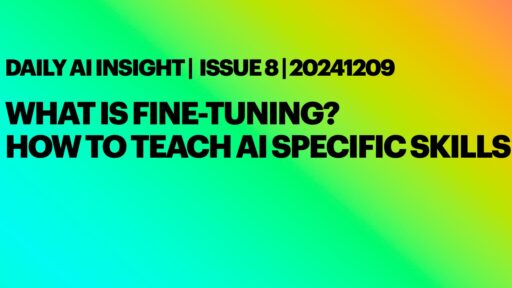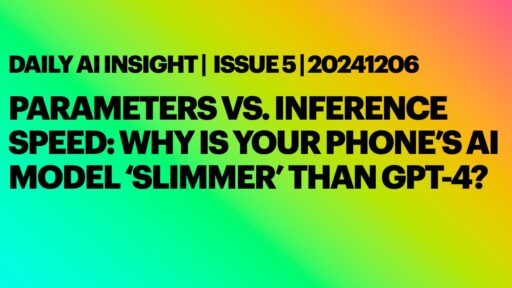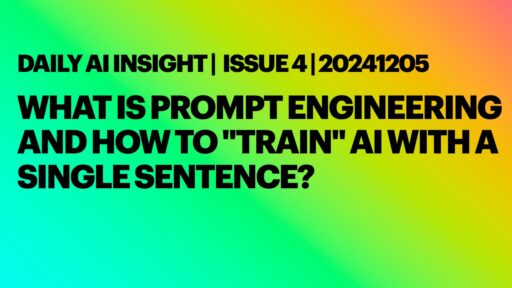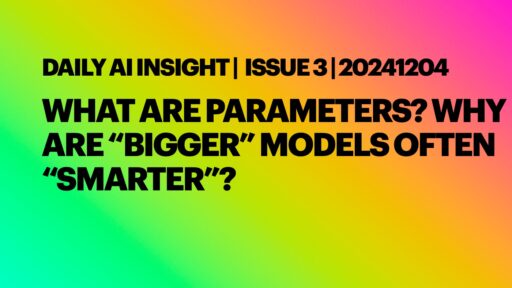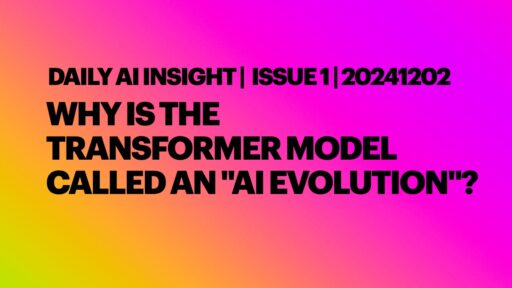Introduction: Why It Matters In the rapidly evolving field of AI, the distinction between foundation models and task models is critical for understanding how modern AI systems work. Foundation models, like GPT-4 or BERT, provide the backbone of AI development, offering general-purpose capabilities. Task models, on the other hand, are fine-tuned or custom-built for specific applications. Understanding their differences helps businesses and developers leverage the right model for the right task, optimizing both performance and cost. Let’s dive into how these two types of models differ and why both are essential. 1. What Are Foundation Models? Foundation models are general-purpose AI models trained on vast amounts of data to understand and generate language across a wide range of contexts. Their primary goal is to act as a universal knowledge base, capable of supporting a multitude of applications with minimal additional training. Examples of foundation models include GPT-4, BERT, and PaLM. These models are not designed for any one task but are built to be flexible, with a deep understanding of grammar, structure, and semantics. Key Features: Massive Scale: Often involve billions or even trillions of parameters (What does parameters mean? You can refer to my previous blog What Are Parameters?). Multi-Purpose: Can be adapted for numerous tasks through fine-tuning or prompt engineering (Please refer to my previous blog What Is Prompt Engineering and What Is Fine-Tuning). Pretraining-Driven: Trained on vast datasets (e.g., Wikipedia, news, books) to understand general language structures (Please refer to ). Think of a foundation model as a jack-of-all-trades—broadly knowledgeable but not specialized in any one field.…
Let's deep dive into pretraining and fine-tuning today! 1. What Is Pretraining? Pretraining is the first step in building AI models. Its goal is to equip the model with general language knowledge. Think of pretraining as “elementary school” for AI, where it learns how to read, understand, and process language using large-scale general datasets (like Wikipedia, books, and news articles). During this phase, the model learns sentence structure, grammar rules, common word relationships, and more. For example, pretraining tasks might include: Masked Language Modeling (MLM): Input: “John loves ___ and basketball.” The model predicts: “football.” Causal Language Modeling (CLM): Input: “The weather is great, I want to go to” The model predicts: “the park.” Through this process, the model develops a foundational understanding of language. 2. What Is Fine-Tuning? Fine-tuning builds on top of a pretrained model by training it on task-specific data to specialize in a particular area. Think of it as “college” for AI—it narrows the focus and develops expertise in specific domains. It uses smaller, targeted datasets to optimize the model for specialized tasks (e.g., sentiment analysis, medical diagnosis, or legal document drafting). For example: To fine-tune a model for legal document generation, you would train it on a dataset of contracts and legal texts. To fine-tune a model for customer service, you would use your company’s FAQ logs. Fine-tuning enables AI to excel at specific tasks without needing to start from scratch. 3. Key Differences Between Pretraining and Fine-Tuning While both processes aim to improve AI’s capabilities, they differ fundamentally in purpose and execution: Aspect Pretraining…
1. What Is Fine-Tuning? Fine-tuning is a key process in AI training, where a pre-trained model is further trained on specific data to specialize in a particular task or domain. Think of it this way: It is like giving a generalist expert additional training to become a specialist. For example: Pre-trained model: Knows general knowledge (like basic reading comprehension or common language patterns). Fine-tuned model: Gains expertise in a specific field, such as medical diagnostics, legal analysis, or poetry writing. 2. Why Is Fine-Tuning Necessary? Pre-trained models like GPT-4 and BERT are powerful, but they’re built for general-purpose use. Fine-tuning tailors these models for specialized applications. Here’s why it’s important: (1) Adapting to Specific Scenarios General-purpose models are like encyclopedias—broad but not deep. Fine-tuning narrows their focus to master specific contexts: Medical AI: Understands specialized terms like "coronary artery disease." Legal AI: Deciphers complex legal jargon and formats. (2) Saving Computational Resources Training a model from scratch requires enormous resources. Fine-tuning leverages existing pre-trained knowledge, making the process faster and more cost-effective. (3) Improving Performance By focusing on domain-specific data, fine-tuned models outperform general models in specialized tasks. They can understand unique patterns and nuances within the target domain. 3. How Does It Work? It typically involves the following steps: (1) Selecting a Pre-trained Model Choose a pre-trained model, such as GPT, BERT, or similar. These models have already been trained on massive datasets and understand the general structure of language. (2) Preparing a Specialized Dataset Gather a high-quality dataset relevant to your specific task. For example: For legal document…
1. What Is an Embedding? An embedding is the “translator” that converts language into numbers, enabling AI models to understand and process human language. AI doesn’t comprehend words, sentences, or syntax—it only works with numbers. Embeddings assign a unique numerical representation (a vector) to words, phrases, or sentences. Think of an embedding as a language map: each word is a point on the map, and its position reflects its relationship with other words. For example: “cat” and “dog” might be close together on the map, while “cat” and “car” are far apart. 2. Why Do We Need Embeddings? Human language is rich and abstract, but AI models need to translate it into something mathematical to work with. Embeddings solve several key challenges: (1) Vectorizing Language Words are converted into vectors (lists of numbers). For example: “cat” → [0.1, 0.3, 0.5] “dog” → [0.1, 0.32, 0.51] These vectors make it possible for models to perform mathematical operations like comparing, clustering, or predicting relationships. (2) Capturing Semantic Relationships The true power of embeddings lies in capturing semantic relationships between words. For example: “king - man + woman ≈ queen” This demonstrates how embeddings encode complex relationships in a numerical format. (3) Addressing Data Sparsity Instead of assigning a unique index to every word (which can lead to sparse data), embeddings compress language into a limited number of dimensions (e.g., 100 or 300), making computations much more efficient. 3. How Are Embeddings Created? Embeddings are generated through machine learning models trained on large datasets. Here are some popular methods: (1) Word2Vec One of…
Today’s topic might seem a bit technical, but don’t worry—we’re keeping it down-to-earth. Let’s uncover the secrets of tokens, the building blocks of AI’s understanding of language. If you’ve ever used ChatGPT or similar AI tools, you might have noticed something: when you ask a long question, it takes a bit longer to answer. But short questions? Boom, instant response. That’s all thanks to tokens. 1. What Are Tokens? A token is the smallest unit of language that AI models “understand.” It could be a sentence, a word, a single character, or even part of a word. In short, AI doesn’t understand human language—but it understands tokens. Take this sentence as an example: “AI is incredibly smart.” Depending on the tokenization method, this could be broken down into: Word-level tokens: ["AI", "is", "incredibly", "smart"] Character-level tokens: ["A", "I", " ", "i", "s", " ", "i", "n", "c", "r", "e", "d", "i", "b", "l", "y", " ", "s", "m", "a", "r", "t"] Subword-level tokens (the most common method): ["AI", "is", "incred", "ibly", "smart"] In a nutshell, AI breaks down sentences into manageable pieces to understand our language. Without tokens, AI is like a brain without neurons—completely clueless. 2. Why Are Tokens So Important? AI models aren’t magical—they rely on a logic of “predicting the next step.” Here’s the simplified workflow: you feed in a token, and the model starts “guessing” what’s next. It’s like texting a friend, saying “I’m feeling,” and your friend immediately replies, “tired.” Is it empathy? Nope—it’s just a logical guess based on past interactions. Why Does AI…
Parameters vs. Inference Speed: Why Is Your Phone’s AI Model ‘Slimmer’ Than GPT-4?
1. What Are Parameters? This was covered in a previous issue: What Are Parameters? Why Are “Bigger” Models Often “Smarter”? 2. The Relationship Between Parameter Count and Inference Speed As the number of parameters in a model increases, it requires more computational resources to perform inference (i.e., generate results). This directly impacts inference speed. However, the relationship between parameters and speed is not a straightforward inverse correlation. Several factors influence inference speed: (1) Computational Load (FLOPs) The number of floating-point operations (FLOPs) required by a model directly impacts inference time. However, FLOPs are not the sole determinant since different types of operations may execute with varying efficiency on hardware. (2) Memory Access Cost During inference, the model frequently accesses memory. The volume of memory access (or memory bandwidth requirements) can affect speed. For instance, both the computational load and memory access demands of deep learning models significantly impact deployment and inference performance. (3) Model Architecture The design of the model, including its parallelism and branching structure, influences efficiency. For example, branched architectures may introduce synchronization overhead, causing some compute units to idle and slowing inference. (4) Hardware Architecture Different hardware setups handle models differently. A device’s computational power, memory bandwidth, and overall architecture all affect inference speed. Efficient neural network designs must balance computational load and memory demands for optimal performance across various hardware environments. Thus, while parameter count is one factor affecting inference time, it’s not a simple inverse relationship. Optimizing inference speed requires consideration of computational load, memory access patterns, model architecture, and hardware capabilities. 3. Why Are…
1. What is Prompt Engineering? Prompt Engineering is a core technique in the field of generative AI. Simply put, it involves crafting effective input prompts to guide AI in producing the desired results. Generative AI models (like GPT-3 and GPT-4) are essentially predictive tools that generate outputs based on input prompts. The goal of Prompt Engineering is to optimize these inputs to ensure that the AI performs tasks according to user expectations. Here’s an example: Input: “Explain quantum mechanics in one sentence.” Output: “Quantum mechanics is a branch of physics that studies the behavior of microscopic particles.” The quality of the prompt directly impacts AI performance. A clear and targeted prompt can significantly improve the results generated by the model. 2. Why is Prompt Engineering important? The effectiveness of generative AI depends heavily on how users present their questions or tasks. The importance of Prompt Engineering can be seen in the following aspects: (1) Improving output quality A well-designed prompt reduces the risk of the AI generating incorrect or irrelevant responses. For example: Ineffective Prompt: “Write an article about climate change.” Optimized Prompt: “Write a brief 200-word report on the impact of climate change on the Arctic ecosystem.” (2) Saving time and cost A clear prompt minimizes trial and error, improving efficiency, especially in scenarios requiring large-scale outputs (e.g., generating code or marketing content). (3) Expanding AI’s use cases With clever prompt design, users can leverage AI for diverse and complex tasks, from answering questions to crafting poetry, generating code, or even performing data analysis. 3. Core techniques in Prompt…
1. What Are Parameters? In deep learning, parameters are the trainable components of a model, such as weights and biases, which determine how the model responds to input data. These parameters adjust during training to minimize errors and optimize the model's performance. Parameter count refers to the total number of such weights and biases in a model. Think of parameters as the “brain capacity” of an AI model. The more parameters it has, the more information it can store and process. For example: A simple linear regression model might only have a few parameters, such as weights ( ww w) and a bias ( bb b). GPT-3, a massive language model, boasts 175 billion parameters, requiring immense computational resources and data to train. 2. The Relationship Between Parameter Count and Model Performance In deep learning, there is often a positive correlation between a model's parameter count and its performance. This phenomenon is summarized by Scaling Laws, which show that as parameters, data, and computational resources increase, so does the model's ability to perform complex tasks. Why Are Bigger Models Often Smarter? Higher Expressive Power Larger models can capture more complex patterns and features in data. For instance, they not only grasp basic grammar but also understand deep semantic and contextual nuances. Stronger Generalization With sufficient training data, larger models generalize better to unseen scenarios, such as answering novel questions or reasoning about unfamiliar topics. Versatility Bigger models can handle multiple tasks with minimal or no additional training. For example, OpenAI's GPT models excel in creative writing, code generation, translation, and…
"Self Attention", a pivotal advancement in deep learning, is at the core of the Transformer architecture, revolutionizing how models process and understand sequences. Unlike traditional Attention, which focuses on mapping relationships between separate input and output sequences, Self-Attention enables each element within a sequence to interact dynamically with every other element. This mechanism allows AI models to capture long-range dependencies more effectively than previous architectures like RNNs and LSTMs. By computing relevance scores between words in a sentence, Self-Attention ensures that key relationships—such as pronoun references or contextual meanings—are accurately identified, leading to more sophisticated language understanding and generation. 1. The Origin of the Attention Mechanism The Attention Mechanism is one of the most transformative innovations in deep learning. First introduced in the 2014 paper Neural Machine Translation by Jointly Learning to Align and Translate, it was designed to address a critical challenge: how can a model effectively focus on the most relevant parts of input data, especially in tasks involving long sequences? Simply put, the Attention Mechanism allows models to “prioritize,” much like humans skip unimportant details when reading and focus on the key elements. This breakthrough marks a shift in AI from rote memorization to dynamic understanding. 2. The Core Idea Behind the Attention Mechanism The Attention Mechanism’s main idea is simple yet powerful: it enables the model to assign different levels of importance to different parts of the input data. Each part of the sequence is assigned a weight, with higher weights indicating greater relevance to the task at hand. For example, when translating the sentence “I…
1. What is the Transformer? The Transformer is a deep learning architecture introduced by Google Research in 2017 through the seminal paper Attention is All You Need. Originally designed to tackle challenges in natural language processing (NLP), it has since transformed into the foundation for state-of-the-art AI models in multiple domains, such as computer vision, speech processing, and multimodal learning. Traditional NLP models like RNNs (Recurrent Neural Networks) and LSTMs (Long Short-Term Memory networks) had two significant shortcomings: Sequential Processing: These models processed text one token at a time, slowing down computations and making it hard to parallelize. Difficulty Capturing Long-Range Dependencies: For long sentences or documents, these models often lost crucial contextual information from earlier parts of the input. The Transformer introduced a novel Self-Attention Mechanism, enabling it to process entire input sequences simultaneously and focus dynamically on the most relevant parts of the sequence. Think of it like giving the model a panoramic lens, allowing it to view the entire context at once, rather than just focusing on one word at a time. 2. Why is the Transformer Important? The Transformer brought a paradigm shift to AI, fundamentally altering how models process, understand, and generate information. Here's why it’s considered revolutionary: (1) Parallel Processing Unlike RNNs that process data step by step, Transformers can analyze all parts of the input sequence simultaneously. This parallelism significantly speeds up training and inference, making it feasible to train models on massive datasets. (2) Better Understanding of Context The Self-Attention Mechanism enables the Transformer to capture relationships between all tokens in a…
